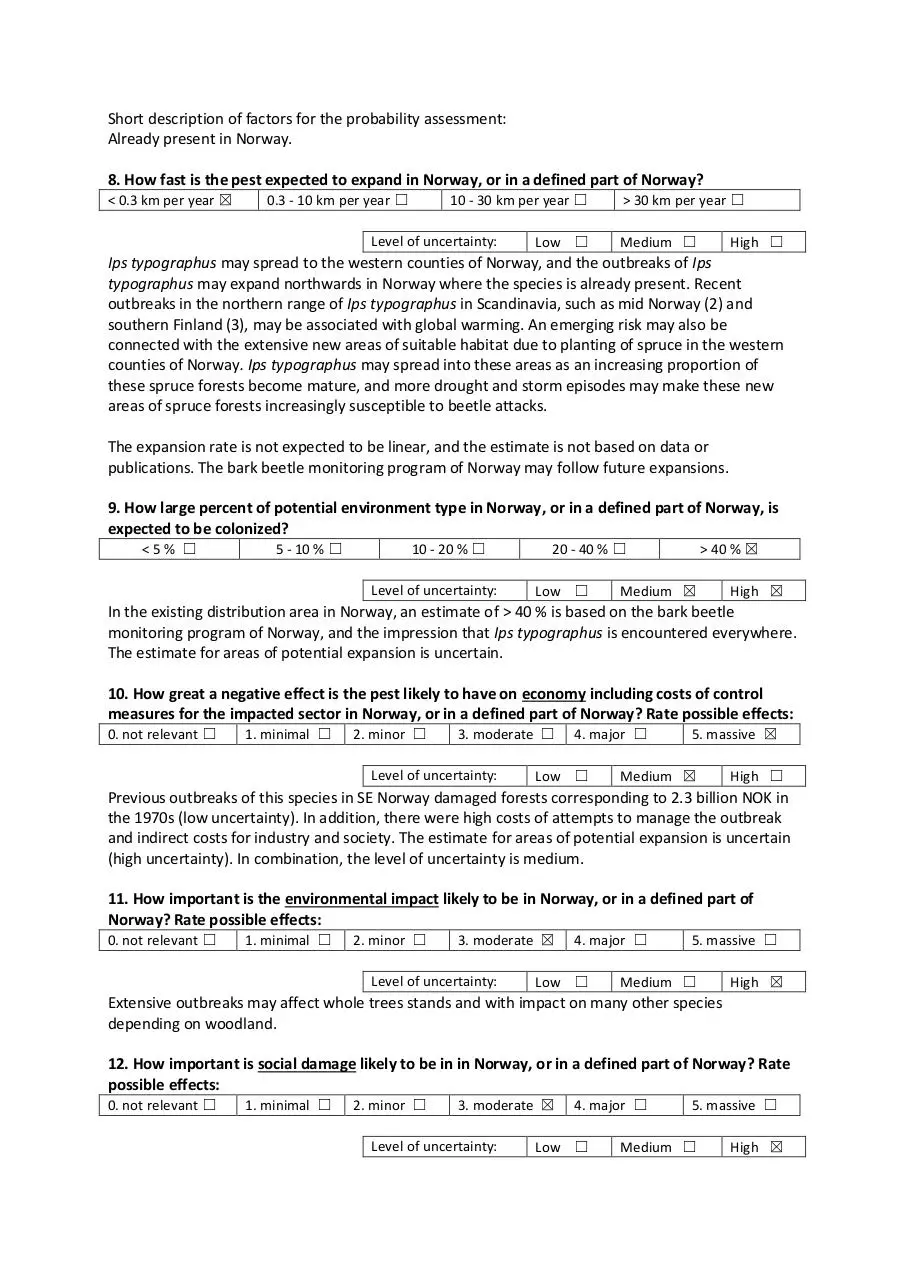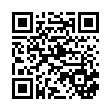Ips typopgraphus (PDF)
File information
This PDF 1.7 document has been generated by Google, and has been sent on pdf-archive.com on 05/04/2017 at 21:56, from IP address 84.208.x.x.
The current document download page has been viewed 240 times.
File size: 585.58 KB (4 pages).
Privacy: public file




File preview
Screening of Emerging risks in Norway (ERIN). Judgments are preliminary and should not be
considered as part of a final risk assessment:
Ips typographus Linnaeus, 1758
1. Taxonomic position Insecta: Coleoptera: Curculionidae: Scolytinae Popular names: Eight-toothed
spruce bark beetle, Eurasian spruce bark beetle, European spruce bark beetle (English); stor
granbarkbille (Norwegian).
2a. Status in Norway:
Established ☒
Intercepted but not established ☐
Not intercepted ☐
Present in Norway far back in time. Known from the counties of Østfold, Oslo, Akershus, Hedmark,
Oppland, Buskerud, Telemark, Aust-Agder, Vest-Agder, Sør-Trøndelag, Nord-Trøndelag and Nordland.
2b. If this species is already established in Norway and this assessment is limited to a part of
Norway where it may expand, define this part area of Norway:
This assessment considers the emerging risk for whole Norway. However, it also considers possible
expansions to regions of Norway (e.g. Vestlandet) (see point 8 and 14).
3. Area of native distribution in the world and information about introductions, expansions and
eradications:
Widespread in spruce regions of Europe and Asia.
4. Sector in Norway expected to be impacted by the species (related to question 10 below):
Agriculture ☐
Forest(ry) ☒
Ornamental/park/garden ☐
Fruit orchard/garden ☐
Greenhouse/protected ☐
Other sector, or not relevant ☐ Describe:
5. Susceptible host(s) and/or type of environment(s) in Norway:
Ips typographus is mainly associated with Norway spruce (Picea abies) and forests dominated by this
tree species. It may also thrive on other coniferous species, such as Sitka and Lutz spruce (NorthAmerican spruce species planted in Norway), and may occur on Pinus sylvestris during periods of high
beetle populations (single trees were colonized during the large outbreak in the 1970s).
6. Description of damage:
The extensive galleries of beetles developing under the bark have a girdling effect on the trees, and
fungi associated with beetles making reaction zones around the entry of the beetles may enhance
the entry and gallery construction of the beetles, and may magnify the lethal effect on the trees.
During outbreaks, the majority of trees in a forest stand may be killed.
7a. How is the overall probability of entry in Norway, or in a defined part of Norway?
0. not relevant ☒
1. very low ☐
2. low ☐
3. medium ☐
Level of uncertainty:
4. high ☐
Low ☐
5. very high ☐
Medium ☐
High ☐
7b. How is the overall probability of establishment in Norway, or in a defined part of Norway?
0. not relevant ☒
1. very low ☐
2. low ☐
3. medium ☐
Level of uncertainty:
4. high ☐
Low ☐
5. very high ☐
Medium ☐
High ☐
Short description of factors for the probability assessment:
Already present in Norway.
8. How fast is the pest expected to expand in Norway, or in a defined part of Norway?
< 0.3 km per year ☒
0.3 - 10 km per year ☐
10 - 30 km per year ☐
Level of uncertainty:
Low ☐
> 30 km per year ☐
Medium ☐
High ☐
Ips typographus may spread to the western counties of Norway, and the outbreaks of Ips
typographus may expand northwards in Norway where the species is already present. Recent
outbreaks in the northern range of Ips typographus in Scandinavia, such as mid Norway (2) and
southern Finland (3), may be associated with global warming. An emerging risk may also be
connected with the extensive new areas of suitable habitat due to planting of spruce in the western
counties of Norway. Ips typographus may spread into these areas as an increasing proportion of
these spruce forests become mature, and more drought and storm episodes may make these new
areas of spruce forests increasingly susceptible to beetle attacks.
The expansion rate is not expected to be linear, and the estimate is not based on data or
publications. The bark beetle monitoring program of Norway may follow future expansions.
9. How large percent of potential environment type in Norway, or in a defined part of Norway, is
expected to be colonized?
<5% ☐
5 - 10 % ☐
10 - 20 % ☐
Level of uncertainty:
20 - 40 % ☐
Low ☐
> 40 % ☒
Medium ☒
High ☒
In the existing distribution area in Norway, an estimate of > 40 % is based on the bark beetle
monitoring program of Norway, and the impression that Ips typographus is encountered everywhere.
The estimate for areas of potential expansion is uncertain.
10. How great a negative effect is the pest likely to have on economy including costs of control
measures for the impacted sector in Norway, or in a defined part of Norway? Rate possible effects:
0. not relevant ☐
1. minimal ☐
2. minor ☐
3. moderate ☐
Level of uncertainty:
4. major ☐
Low ☐
5. massive ☒
Medium ☒
High ☐
Previous outbreaks of this species in SE Norway damaged forests corresponding to 2.3 billion NOK in
the 1970s (low uncertainty). In addition, there were high costs of attempts to manage the outbreak
and indirect costs for industry and society. The estimate for areas of potential expansion is uncertain
(high uncertainty). In combination, the level of uncertainty is medium.
11. How important is the environmental impact likely to be in Norway, or in a defined part of
Norway? Rate possible effects:
0. not relevant ☐
1. minimal ☐
2. minor ☐
3. moderate ☒
Level of uncertainty:
4. major ☐
Low ☐
5. massive ☐
Medium ☐
High ☒
Extensive outbreaks may affect whole trees stands and with impact on many other species
depending on woodland.
12. How important is social damage likely to be in in Norway, or in a defined part of Norway? Rate
possible effects:
0. not relevant ☐
1. minimal ☐
2. minor ☐
3. moderate ☒
Level of uncertainty:
4. major ☐
Low ☐
5. massive ☐
Medium ☐
High ☒
Extensive outbreaks in new areas of Norway may have a significant impact on communities
dependent on forestry and forest industries.
13. Priority in Norway versus EPPO and EU:
Ips typographus is widespread in spruce-dominated regions of Europe, and this pest species is not in
focus for management of invasive species in EPPO and EU, except in United Kingdom and Ireland
where it is absent and import of conifers is under strict regulation (4). Concern about this species in
Norway is still necessary due to its potential of range expansions
14. Specific questions for Norway:
The main host of Ips typographus is extensively planted in western Norway, while it is not known to
what extent the marine climate in western Norway is suitable for this beetle species to establish and
make outbreaks. Furthermore, Ips typographus is already present in the extensive spruce forests in
Trøndelag and the southern part of Nordland, while these regions had no outbreaks of Ips
typographus up to recently. More knowledge is needed about climatic requirements to evaluate the
potential of range expansions of Ips typographus and its outbreaks in Norway.
15. Existing assessments:
No risk assessments have been made for Norway. CABI has developed a data sheet of Ips
typographus for EPPO (1), and invasive pest risk maps have been developed in USA (5). Range
expansions due to global warming and access to new areas spruce have not been treated in these
documents.
16. Requested assessments:
There are no assessments of Ips typographus requested by Norwegian Food Safety Authority
(Mattilsynet) or Norwegian Environment Agency (Miljødirektoratet).
17. Recommended type of assessment:
A PRA for Noway is recomended
References
1. Ips typographus. Data Sheets on Quarantine Pests. CABI and EPPO. URL:
http://www.eppo.int/QUARANTINE/insects/Ips_typographus/IPSXTY_ds.pdf
2. Økland, B., Christiansen, E. & Wollebæk, G. 2009. Granbarkbillen. Registrering av
bestandsstørrelsene i 2009. Oppdragsrapport fra Skog og landskap 21/09: 14 s. URL:
http://www.skogoglandskap.no/fagartikler/2007/status_barkbilleovervaking
3. Neuvonen, S., Tikkanen, O., Vanhanen, H. and Viiri, H. 2015. Bark beetle damage on Norway
spruce has recently increased in Finland – monitoring results and management implications.
Poster at IUFRO 07.03.05 – 07.03.12 Joint Meeting. Bariloche September 1st – 4th, 2015.
URL: https://drive.google.com/file/d/0Bxd4ZXAjPsaVVUgzVlpFM1hNOXM/view.
4. EU imports - Protected zones – Conifers. Forestry Comission, UK. URL:
http://www.forestry.gov.uk/forestry/infd-9qhl9z.
5. European spruce bark beetle - Ips typographus. Invasive Pest Risk Maps. Forest Health
Technology Enterprise Team. United States Department of Agriculture. URL:
http://www.fs.fed.us/foresthealth/technology/invasives_ipstypographus_riskmaps.shtml
and http://www.invasivespeciesinfo.gov/animals/eurosbb.shtml.
Vedlegg 1. PM 5/3(5). Decision-support scheme for quarantine pests (version 2011). EPPO. Kan lastes
ned her: http://archives.eppo.int/EPPOStandards/pra.htm.
Vedlegg2. Guidance to the questions 7 and 10 in the scheme
Vedlegg 3. Ratings used for describing the level of uncertainty
Download Ips typopgraphus
Ips typopgraphus.pdf (PDF, 585.58 KB)
Download PDF
Share this file on social networks
Link to this page
Permanent link
Use the permanent link to the download page to share your document on Facebook, Twitter, LinkedIn, or directly with a contact by e-Mail, Messenger, Whatsapp, Line..
Short link
Use the short link to share your document on Twitter or by text message (SMS)
HTML Code
Copy the following HTML code to share your document on a Website or Blog
QR Code to this page

This file has been shared publicly by a user of PDF Archive.
Document ID: 0000578784.